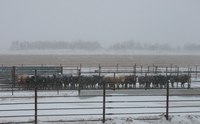Winter Weather Requires Major Shift in Cattle Management
(Click the image below to view a high-resolution image that can be downloaded)
Winter weather has replaced warm fall temperatures, so cattle producers need to change the way they care for their animals, North Dakota State University Extension Service livestock specialists say.
“Two major blizzards have made their way through the region, bringing heavy snow and raging winds,” beef cattle specialist Carl Dahlen says. “Cattle are feeling the rapid transition from mild fall to extreme winter, and producers need to take steps to make the transition as comfortable as possible while remaining safe themselves.”
Substantial drifting occurred in some areas, restricting cattle’s access to feed and water. Producers should restore access to water and feed and move cattle to wintering areas as soon as possible, according to John Dhuyvetter, area livestock systems specialist at the North Central Research Extension Center near Minot. He also reminds producers to try to prevent cattle from being injured if they are competing for limited water space.
Snow is not a sufficient source of water if cattle are not acclimated to it and major drifting has compacted the snow. The specialists recommend spreading feed out so all cattle have access. Also, cattle will need extra feed while they are becoming acclimated to cold temperatures.
“However, if cows are being maintained on relatively poor-quality feeds or temperatures get too extreme, altering the amount of feed will not meet the increased energy requirements for the cattle,” says Karl Hoppe, area livestock systems specialist at the Carrington Research Extension Center. “Feeds of higher nutrient quality (more energy dense) must be included to achieve the needed level of nutrition during cold spells.”
Some feeds can be dangerous if hungry cattle are allowed full access. For example, grains and high-quality alfalfa can cause digestive disturbances or bloat if cattle consume too much.
Another strategy for dealing with the cold weather is to feed cattle at night. The heat from digestion peaks a few hours after a meal, so offering meals in the evening can help cattle cope with cold nighttime temperatures.
“Consider supplying enough feed for several days to cattle in cases when additional snowfall and drifting are forecast and could restrict cattle’s access to feed for a period of time,” beef quality specialist Lisa Pederson says.
In feedlot settings, cattle may back off feed for a day or several days, so producers must make sure to get them eating pre-storm rations. Limit feeding or feeding smaller amounts several times a day can avoid digestive disturbances in feedlot cattle. Another option is to reduce dietary energy for a period of time by adding more roughage, then following that with a gradual transition back to high-energy finishing rations.
“Take steps to ensure cattle are out of the wind,” livestock stewardship specialist and veterinarian Gerald Stokka says. “If natural windbreaks (trees, draws, etc.) are available, take advantage of them for choosing wintering sites. If no natural windbreaks exist, producers will need to take steps to make permanent or portable windbreaks to protect cattle from the wind. Portable panels are good options for producers maintaining cattle in relatively open country.”
Bedding may not always be necessary for wintering cow herds, but in cases where cattle are wet, it is a must. Bedding helps keep cattle dry. It also can provide a reprieve for cattle that have been standing or walking for several days after storms.
The specialists also recommend producers watch their cattle closely for health conditions that arise from exposure to winter weather. Hypothermia and frostbite may be apparent immediately, but cattle can be at risk for pneumonia and other conditions for several weeks after severe events. Producers should talk with their veterinarian to establish treatment plans for any anticipated or observed illness.
If producers lose cattle to bad weather, they need to keep records of those deaths. Financial assistance may be available through the Livestock Indemnity Program (LIP) for losses directly resulting from blizzards and winter storms. To qualify for funds, producers need to provide a notice of loss to their local Farm Service Agency within 30 days of the event. The LIP is designed on a calendar year basis, so claims for December storms need to be finalized in early 2017.
Producers need to protect themselves from the weather as well.
“We all want to make sure our cattle are fed and properly bedded before the storm breaks or the temperatures plummet,” Dahlen says. “Just take a few moments to make sure you are dressed appropriately before heading out the door.”
The specialists also suggest that once the cattle are cared for, producers should check with friends and neighbors to see if they need extra help.
“Everyone’s labor and equipment situations are different, and dramatically different effects of storms can be seen on farmsteads even a short distance away,” Dhuyvetter says.
For assistance with ration formulation, feeding recommendations or other winter management concerns, contact your county Extension office (https://www.ag.ndsu.edu/extension/directory). For additional materials related to post-storm management of cattle, visit https://www.ag.ndsu.edu/cattledocs.
NDSU Agriculture Communication - Dec. 15, 2016
| Source: | Carl Dahlen, 701-231-5588, carl.dahlen@ndsu.edu |
|---|---|
| Source: | John Dhuyvetter, 701-857-7682, john.dhuyvetter@ndsu.edu |
| Source: | Karl Hoppe, 701-652-2951, karl.hoppe@ndsu.edu |
| Source: | Lisa Pederson, 701-328-9718, lisa.pederson@ndsu.edu |
| Source: | Gerald Stokka, 701-231-5082, gerald.stokka@ndsu.edu |
| Editor: | Ellen Crawford, 701-231-5391, ellen.crawford@ndsu.edu |


